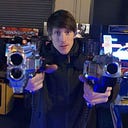Game Retrospective: Zone of the Enders
On the 26th of March 2001, Zone of the Enders was released for the Sony PlayStation 2 in North America. The game had made its debut in Japan at the start of the month and released across Europe just a couple of days before its launch in the US.
Developed by Konami, Zone of the Enders was famously produced by Metal Gear Solid series creator Hideo Kojima. Noriaki Okamura, who had previously worked as the main programmer for Kojima’s 1994 title, Policenauts, would serve as the game’s director. Yoji Shinkawa and Nobuyoshi Nishimura, both of whom had worked on several entries in the Metal Gear Solid series, were brought on as lead artists on the game, with Shinkawa designing the in-game mechs, while Nishimura handled the character designs and promotional illustrations.
Zone of the Enders takes place in the year 2172 on the Jupiter-orbiting space colony, Antilia. A formidable military force known as BAHRAM has begun attacking the colony in an effort to secure two advanced robot-like mechanical battle units (known as Orbital Frames), killing and destroying everything in their way. The player is cast as Leo Stenbuck, a young colonist caught up in the conflict. Upon witnessing the death of his friends, Leo seeks refuge in a nearby warehouse where he discovers an Orbital Frame called Jehuty. After climbing in the cockpit, Leo finds himself using the mech, with some assistance from ADA, the frame’s in-built AI, to fend off a surprise attack on the warehouse. He is promptly contacted by the United Nations Space Force who request Leo’s help in delivering the Orbital Frame to them. On his mission, Leo finds himself rescuing colonists, destroying invading forces and defending colony settlements, as well as repeatedly encountering Viola, a driven and extremely-skilled BAHRAM officer, obsessed with Leo’s destruction.
Development on Zone of the Enders began around 1998, several years before the release of the PlayStation 2 console. Speaking to IGN in 2000, director Noriaki Okamura, shared some details regarding the early days of the game’s development. “We actually started developing the game on the PlayStation and the PC, but we weren’t planning to release the game on those systems. We knew that we were going to release the game on some next-generation machine, which turned out to be the PS2.”
A series of tweets from September 2019, by Zone of the Enders Art Director Toshio Noguchi, even confirmed that early prototypes of the game were even built upon Sega Dreamcast hardware, as well as sharing the game’s original working title. After posting some artwork from the game, with a Sega Mega Drive book in the background, Noguchi tweeted: “There’s no link between ZOE & the Mega Drive, but the temp title [for Zone of the Enders] was MEGADRIVER. It was a term reserved for that one [Sega] Mega Drive maniac we all knew, and because the initial ZOE prototypes were for Dreamcast, the title came naturally.” When asked whether he would have liked to have seen the game come to Dreamcast, he went on the reply: “I wish I could make Z.O.E multi-platform, but we couldn’t because Dreamcast and PlayStation 2 had different strengths, but I wanted to see Dreamcast-optimized Z.O.E.”
When designing the game’s mechs, Shinkawa, revisited several pieces of art from his past for inspiration. In a series of now-archived interviews from Konami’s official site, when asked about the Orbital Frame’s distinctive silhouettes, Shinkawa shared: “I looked over sketches I did as a student, and we were like “Why not go with this!” He goes on to explain the origin of the main mech’s name, Jehuty. Derived from the Egyptian God DJehuty, it was suggested by another member of the team in response to Shinkawa’s earlier designed character, Anubis. “Anubis is a name from my school days. I did not have Egyptian mythology in mind when I worked on the other characters, but I guess that person thought this robot had that kind of image as well.” Before the name Jehuty was suggested, Shinkawa shared that Anubis’ opponent mech [Jehuty] originally had the name ‘Fortune’.
Upon release, Zone of the Enders was praised for its visual design, tight gameplay and quick fighting system. The game’s length, relative lack of difficulty and voice acting, however, drew criticism by several gaming publications. Zone of the Enders would release with an additional demo disk for the highly-anticipated Metal Gear Solid 2: Sons of Liberty, which reportedly boosted the game’s sales. The game would go on to receive the 2001 Game Boy Advance spin-off, Zone of the Enders: The Fist of Mars, as well as a direct sequel, 2003’s PS2 release, Zone of the Enders: The 2nd Runner.
🕹Are you a fan of Zone of the Enders? Did you enjoy its sequel or Game Boy Advance spin-off? Have you tried the VR HD re-release of Zone of the Enders 2? Would you like to see the series make a return?🕹
